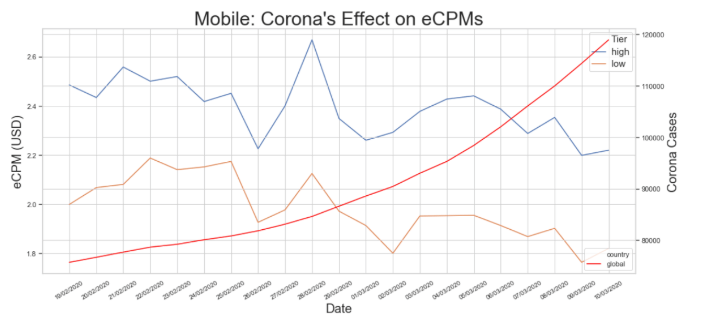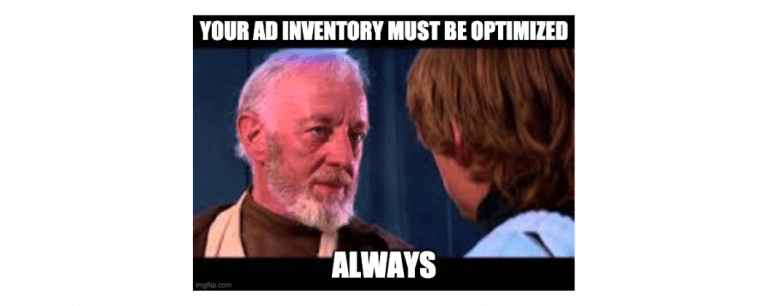Publishers: The Light at the End of the Coronavirus Tunnel
By Asaf Shamly | January 28, 2021

There is no doubt that we are currently in the midst of possibly the biggest crisis most of us have ever seen. Recently, I was discussing with a colleague, that this might have the biggest global impact since the second world war.
The impact has been quite heavy when it comes to publishers dealing with their advertising income. Among the myriad of challenges they are facing, the bottom line ultimately boils down to a significant drop in CPMs and diminished revenue.
That being said, this will end, and time will get back to normal.
For publishers, it is important to remember they can work through this, and there will be future crises, so learning the lessons from this one is crucial.
With that in mind, there are a few tips we want to share to help see the light at the end of the tunnel.
Embrace Programmatic Ads
In times of uncertainty, direct sales will undoubtedly struggle for many reasons. A great point made by Michael Lehman in his article states that currently the face-to-face meetings that are necessary around direct sales are not going to happen.
Additionally, advertisers will look for places to cut spend when crises are hurting the economy. The trend we are seeing is that this will cause not just immediate scaling back, but a lack of commitment to direct campaigns in the foreseeable future.
Ultimately, advertisers will turn towards a marketplace structure, programmatic or PMPs, to provide the agility they need, test what works on smaller scales, optimize for ROI all with shorter commitments.
These actions taken by advertisers creates a perfect storm on the publisher side that results in lower demand, diminished ad quality and a significant drop in eCPMs
As this shift happens, to stay afloat publishers need to follow suit and make programmatic the top priority. More than ever it is crucial to ensure high ad quality for every impression sold.
Real-Time Viewability Prediction to Increase Programmatic CPMs
The solution for publishers is optimizing for viewability in real-time. By raising the viewability level on all impressions across their site, publishers will be able to sell placements based on their high ad quality, lift their CPMs and conquer the migration to programmatic buying.
The key element to accurately lifting the floor price on CPMs is the ability for publishers to predict the viewability of an impression, at the ad-call level. With granular prediction capabilities, publishers can understand which impressions are premium allowing them to adjust their floor prices based on the viewability levels.
You can see in the chart below an average of three different Browsi Publisher Partners, specifically leaders on Comscore across news and sports, and their CPMs over the course of the coronavirus outbreak.

The blue line, labeled “high”, is when viewability prediction is above 70%; and the orange line, labeled “low”, is below 70% viewability prediction. Clearly, even during the coronavirus period, the ability to predict and provide higher viewability translates into significantly higher eCPMs for publishers
Your Ad Inventory Must Be Optimized…..Always
A healthy ad inventory has a fluid, continual optimization process, in which publishers experience peak viewability, scale, and CPMs while keeping UX intact.
Most publishers today take a manual approach which results in long and arduous processes such as: site redesign, A/B testing, lazy loading, amongst many others. By the time publishers have put months of work into it, they have to start over again, and find themselves falling behind the real-time activities of advertisers.
The evolution from what most publishers are doing to a healthy ad inventory comes from a real-time platform that utilizes AI technology. AI can assess hundreds of data points and understand them to automatically produce the highest combination of viewability, scale, and UX, such as Browsi provides.
For this reason, whether in normal time, or times of crises like we currently find ourselves, ad inventories should be optimized automatically and in real-time. Always. Furthermore, publishers will be able to allocate precious resources to other departments, instead of worrying about ad inventory falling behind, especially at this time.

Overcoming Corona and Future Crises
We may never see another crisis like this in our lifetime, hopefully, but we can be sure other difficult times will come our way. The best way to be prepared is to have the correct processes in place; not just for when disaster hits, but in good times as well.
By ensuring their ad inventory is optimized in real-time, publishers are ensuring that when dark times do come, they will be good to go and have that guiding light at the end of the tunnel.
Get By With a Little Help From Your Friends
Understanding that this is a difficult time for publishers, we at Browsi wanted to do something to make things a little easier on our community.
Right now we are offering the first 2 months of Browsi usage for free, to help you increase ad inventory performance & mitigate revenue loss.
Contact us to learn more.
Latest Articles
-

You Get What You Surface: How GPT-5 Exposed the Quiet Power of Defaults
The GPT-5 rollout quietly exposed how much defaults shape trust, perception, and engagement. When technology changes without context, even progress can feel like loss. In AI and advertising alike, it’s a reminder that the way we present intelligence — not just how we build it — determines what people understand, value, and believe.
View Now -

What Sales Got Right About Competitive Intelligence – and Why It’s Time for Advertisers to Catch Up
In sales, competitive intelligence became second nature — the reason teams know why deals were won or lost. Advertisers, on the other hand, are still optimizing in the dark. It’s time to bring the same discipline to marketing, and finally see beyond surface-level metrics.
View Now -

AI is Rewriting the Attention Economy, Advertisers are at Risk of Getting Sidelined
AI is rewriting the attention economy. Perplexity’s “citations, not clicks” payouts and Cloudflare’s pay-per-crawl model mark a new phase where platforms set the rules of visibility. Unless brands and agencies demand clarity, control, and real behavioral signals, performance will be optimized to interfaces, not outcomes.
View Now
